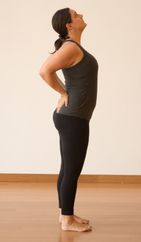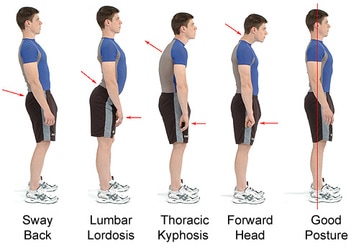If you’re sitting in your office look around and observe the postures around you. Regardless of how much your boss has spent on chairs most postures will be similar to the illustration on the left – slumped forward, rounded lower & middle back, shoulders hunched, chin jutting out that compresses the back of neck. The almost continuous forward bending that most of us put our spines through (observe your posture when sitting at work, on your commute, at home relaxing on the sofa etc.) puts pressure on your discs that moves them towards your spinal nerve, potentially causing pain and stiffness, and almost certainly exacerbating any injuries / wear and tear in your spine.
Imagine that there was no chair/desk in the picture and ask what does the posture on the left tell you about that person – defensive, under pressure, introspective, tired? Then ask what the posture on the right says – alert, focused, confident?
Our posture can be a reflection of our mental state/energy levels, but it’s equally true that our posture can impact our mood and energy levels.
If you practise yoga regularly then chances are you’ve already noticed that different body positions affect how we feel, which can impact how we behave and perform in our lives. Once you understand that you start using different postures to give yourself what you need – for example in my morning classes we do lots of back bends (starting gently of course) to wake us up and energise ourselves for the day ahead. Here’s a very easy yoga posture you can try at your desk so you can see for yourself (and it’s perfect to counter balance the poor posture most of us sit at our desks in):
Standing Back Bend

- Stand with your knees slightly bent and place your palms on your lower back (fingers pointing down);
- Gently draw your elbows/shoulder blades towards eachother to stretch the shoulders back and open your chest;
- Imagine there’s a piece of string attached to the middle of your chest and as your inhale visualise it’s being pulled directly upwards;
- As you exhale pull your lower tummy muscles up & in, allowing your spine to grow taller as best you can.
- Repeat for a few slow and controlled breaths, adding a little wiggle of the hips/shoulders if you feel it helps you grow taller.
So did you notice anything? Did you feel anything in your back? Did you notice that your lung capacity was increased and your breath became deeper (instead of your abdomen and lungs being squashed and restricted in a typical office posture)? Did you feel increased blood circulation and oxygen content, energising your muscles and feeding your brain? Did you notice any discs in your back moving away from your spinal column? Do you feel a bit more alert and awake?
You might struggle to notice anything at first, especially if you’re not used to paying attention to your body in this way – indeed you might even find it a bit uncomfortable because you’re not used to moving your spine at all…in which case please don’t stop, just go very gently! With regular practice and patience you will start to notice more – try doing it once an hour with your colleagues and see if it affects the mood and energy levels in your office?
Here are our top 5 benefits of a great posture:
- You look good, you feel good – everyone who sees you will associate your posture with control & confidence, you’ll start to feel these things about yourself too because they’re true!
- It improves the depth & quality of your breath – your abdomen becomes free and relaxed, allowing you to breathe more easily using your diaphragm (not your chest muscles).
- Feel calm, relaxed and focused – restricted breathing becomes rapid & shallow, which can result in feelings of unease or even panic; relaxed breathing means that you’re going to feel more relaxed, stress is inevitable in life but it doesn’t have to become all-encompassing.
- Avoid health problems – a prolonged poor posture will eventually lead to pain and stiffness, disc related injuries and unnecessary suffering.
- Perform better – whether you’re trying to win a football match or write a fantastic report, we all perform best when we’re calm and focused, that means easy breathing and not being distracted by things like pain in our back/neck/shoulders!
Maybe the changes are too subtle for your mind to notice (maybe your gut is telling you something different)? Maybe your energy levels are too low because you’ve been slumped forward for so long and just can’t be bothered? Maybe reading this and trying the gentle stretch above will plant a seed that leads you to understand yourself better and maximise your potential?
To improve your posture all you have to do is start observing your posture in your daily life and try making little changes here and there – set a reminder on your phone to check your posture, get up and move around after 45 minutes of sitting, change your desk/chair position, try a cushion behind your lower back, sit with both feet flat on the floor, avoid carrying heavy loads on one shoulder, etc.
If you want to improve your spinal flexibility & strength so you can get into and maintain correct spinal alignment, yoga and/or pilates classes are where you’ll find the skills you need. If your already experiencing problems with your posture then the sooner you accept that these skills are the most effective way of dealing with your problems, the better off you’ll be.

It’s up to you – you’re the most qualified expert in the world on you. Try for yourself, with a small amount of effort you may just uncover surprising powers for positive changes in your life!


